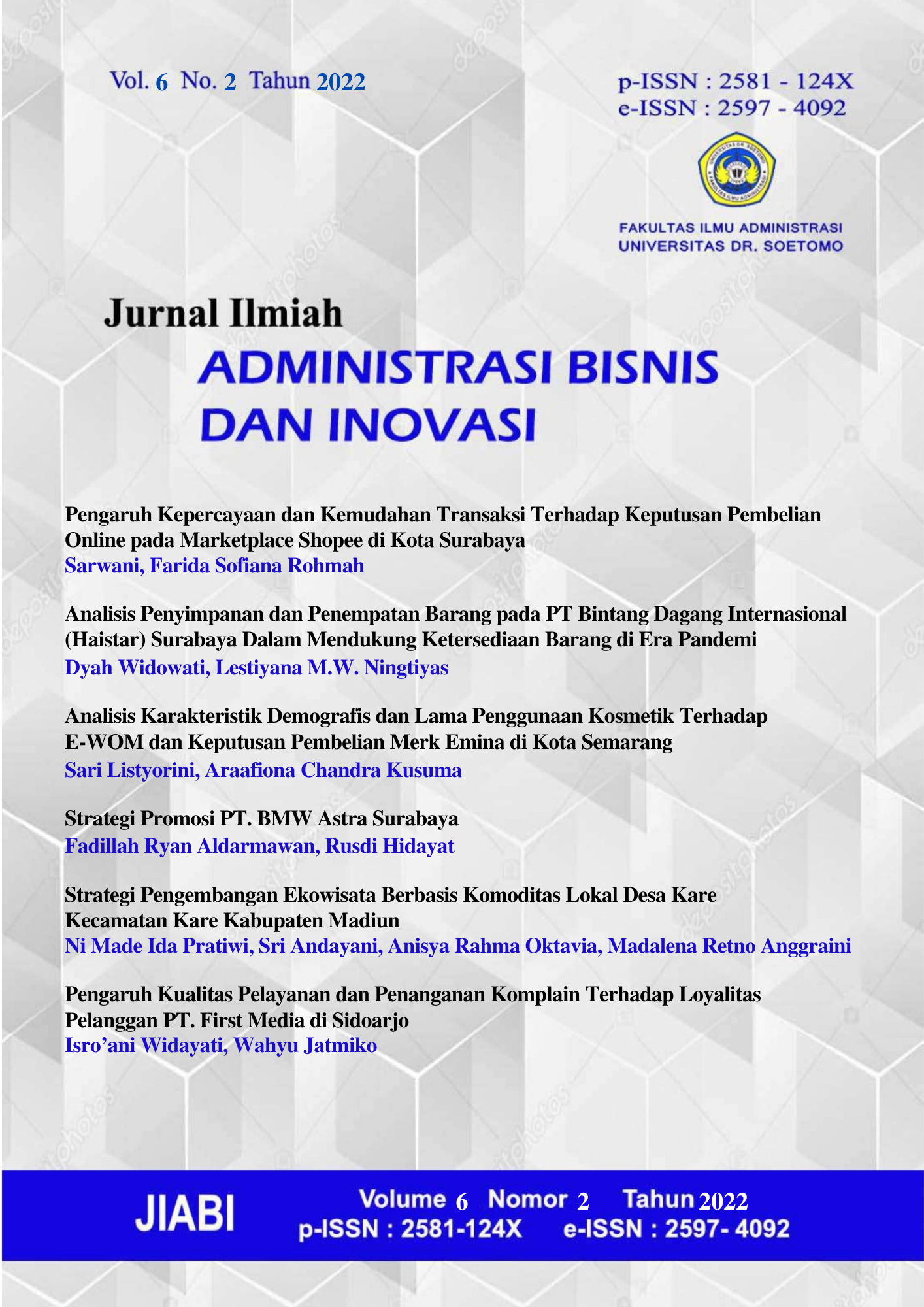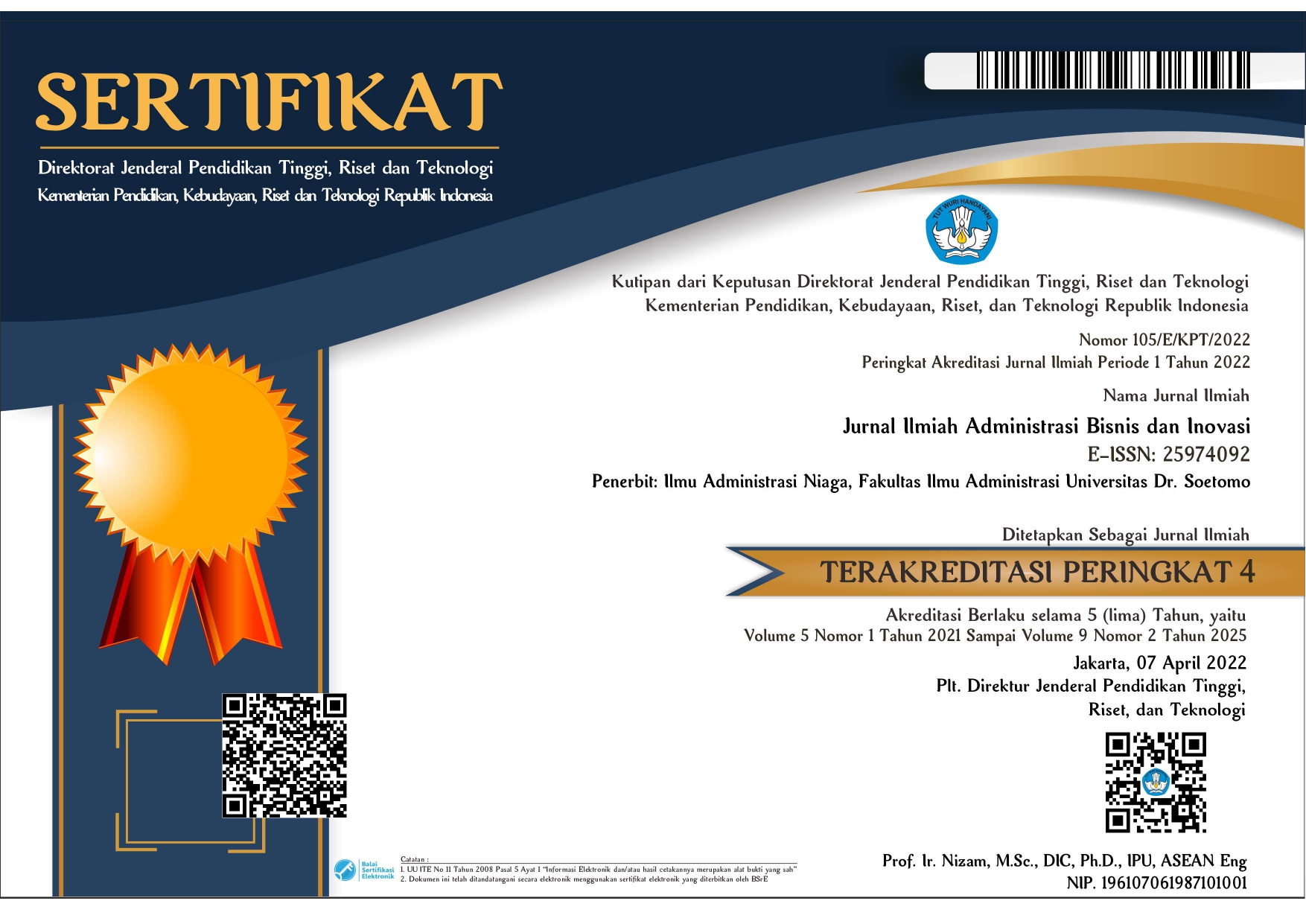Analisis Karakteristik Demografis Dan Lama Penggunaan Kosmetik Terhadap E-WOM Dan Keputusan Pembelian Merk Emina di Kota Semarang
 Abstract views: 288
,
Abstract views: 288
,
 Full Text (PDF) downloads: 420
Full Text (PDF) downloads: 420
Abstract
Cosmetics are currently a commodity that is needed by women to support their daily appearance. As a primary need for women, of course, the cosmetics industry encourages higher competition, one of which is Emina as a local cosmetic brand in Indonesia. Local brands certainly not easy to occupy the top position compared to imported brands. Thus the ability of E-Wom to influence purchasing decisions is very important by taking into account the demographic characteristics of consumers in Indonesia. This study aims to determine the effect of E-Wom on purchasing decisions with the moderation of demographic characteristics and length of use. This study used a sample of 100 respondents who live in Semarang, Central Java. This research was conducted by distributing questionnaires directly and questionnaires in the form of google forms. The analytical tool used in this research is WarpPls analysis. The results showed that E-Wom had a significant effect on purchasing decisions, the length of use of cosmetics had a significant effect as a moderator between E-Wom and purchasing decisions, demographic characteristics, namely age and income level, had no significant effect on moderating the relationship between E-Wom and purchasing decisions. Emina Cosmetics needs to consider the role of the best experiences from consumers as users of local cosmetics because with experience, consumers can provide the best information to others. This experience can be applied in the form of product and pricing strategies that are better than before.
Keywords: E WOM; Demographic characteristics; prolonged use of cosmetics; buying decision
References
Chevalier, J. and Mayzlin, D. (2006), “The effect of word-of-mouth on sales: online book reviewsâ€, Journal of Marketing Research, Vol. 43 No. 3, pp. 345-354.
Fang, Y.H. 2014. Beyond the credibility of electronic word of mouth: Exploring E WOM adoption on social networking sites from affective and curiosity perspectives. International Journal of Electronic Commerce 18, no. 3: 67–102
Farkas, M.F., Gholampour, A., Bouzari, P., Jarghooiyan H., Ebrahimi, P,. (2021). How gender and age can affect consumer purchase behavior? Evidence from A microeconomic perspective from Hungary, D-minister Nº. 39 July - December 2021, pp. 25 - 46 · ISSN 1692-0279 · eISSN 2256-4322
Goyette et al, (2010). e-WOM Scale: Word-of-Mouth Measurement Scale for e-Services Context; Canadian Journal of Administrative Sciences. Vol.27,. Pp 5–23.
Haji, R., & Stock, W. G. (2021). User settings for advertising optimization on Facebook: Active customer participation or settings blindness? Telematics and Informatics, 59. https://doi.org/10.1016/j. tele.2020.101548
Hennig-Thurau, T., Gwinner, K.P., Walsh, G. & Gremler, D.D. (2004). Electronic word-of-mouth via consumer opinion platform: what motivates consumers to articulate themselves on the internet?. Journal of Interactive Marketing, 18, 38-52.
Jiunn-Woei Lian, D. C. (2014). Online shopping drivers and barriers for older adults: Age and gender differences. Computers in Human Behavior, 133-143.
Kotler, Philip, (2003). Manajemen Pemasaran. Edisi Kesebelas. Indeks Kelompok Gramedia. Jakarta
Kotler, P. &. (2012). Manajemen Pemasaran Jilid 1 dan 2 . Jakarta: Erlangga.
Lee, C.H. and Cranage, D.A. (2014), “Toward understanding consumer processing of negative online word-of-mouth communication: the roles of opinion consensus and organizational response strategiesâ€, Journal of Hospitality & Tourism Research, Vol. 38 No. 3, pp. 330-360.
Lin, Chinho, Yi Shuang Wu, Jeng-Chung Victor Chen. (2013). Electronic Word of Mouth: The Moderating RolesOf Product Involvement And Brand Image. Thailand.
Sari Listyorini, R. E. (2021). The Power of Influencers as Comparative Models of Social Models in the Selection of Local Fashion Brands. ICISPE 2021 . Semarang: eudl.
Munandar. (2017). Faktor-Faktor Yang Mempengaruhi Perilaku Konsumen Dalam Membeli Kopi Espresso. Jurnal Visioner & Strategis, 6(1).
Poturak, M., Turkyilmaz, M., (2018). The Impact Of E WOM In Social Media On Consumer Purchase Decisions: A Comparative Study between Romanian and Bosnian Consumers, Management and Economics Review, Volume 3, Issue 2
Schiffman, L.G dan Kanuk, Lesley L, 2007. Consumer Behavior, New Jersey: Person Prestice Hall.
Schiffman, Leon, & Leslie Lazar Kanuk. (2008). Consumer Behaviour 7th Edition (Perilaku Konsumen). Jakarta: PT. Indeks.
Schifman, L.G & Kanuk, L. L. (2010). Consumer Behavior. New Jersey: Pearson Education, Inc.
See-To, E.W., and K.K. Ho. 2014. Value co-creation and purchase intention in social network sites: The role of electronic Word-of-Mouth and trust – a theoretical analysis. Computers in Human Behaviour 31: 182–9
Senecal, S. & Nantel, J. (2004). The influence of online product recommendations on consumers’ online choices. Journal of Retailing, 80(2), 159-169.
Sudharto P. Hadi. (2007). Perilaku Konsumen. Semarang: Badan Penerbit Universitas Diponegoro.
Wang, Y. and Yu, C. (2015), “Social interaction-based consumer decision-making model in social commerce: the role of word of mouth and observational learningâ€, International Journal of Information Management
Wolny, J. and Mueller, C. (2013), “Analysis of fashion consumers’ motives to engage in electronic word of mouth communication through social media platformsâ€, Journal of Marketing Management, Vol. 29 Nos 5/6, pp. 562-583
Copyright (c) 2022 Sari Listyorini

This work is licensed under a Creative Commons Attribution-NonCommercial-ShareAlike 4.0 International License.
Authors who publish with Inform: JIABI: Jurnal Ilmiah Administrasi Bisnis dan Inovasi agree to the following terms:
Authors retain copyright and grant the journal right of first publication with the work simultaneously licensed under a Creative Commons Attribution License (CC BY-SA 4.0) that allows others to share the work with an acknowledgment of the work's authorship and initial publication in this journal.
Authors are able to enter into separate, additional contractual arrangements for the non-exclusive distribution of the journal's published version of the work (e.g., post it to an institutional repository or publish it in a book), with an acknowledgment of its initial publication in this journal.
Authors are permitted and encouraged to post their work online (e.g., in institutional repositories or on their website) prior to and during the submission process, as it can lead to productive exchanges, as well as earlier and greater citation of published work.









